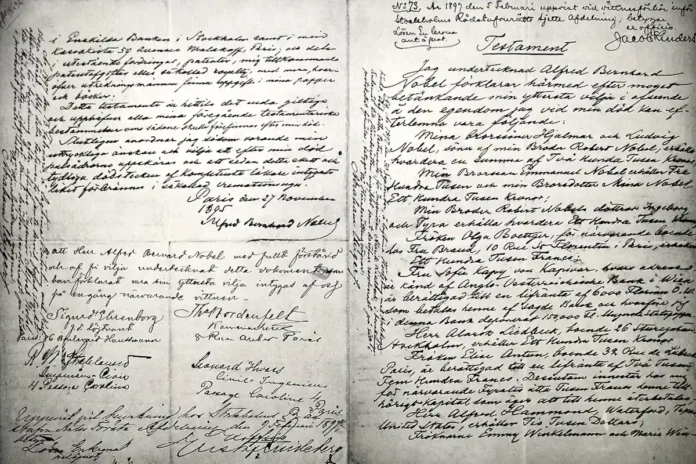When visiting Stockholm, the capital city of Sweden, one of the most intriguing historical figures to explore is Alfred Nobel.
Known worldwide as the inventor of dynamite and the founder of the prestigious Nobel Prize, Nobel’s legacy is deeply woven into the fabric of Stockholm. This article delves into his biography, groundbreaking inventions, and the lasting influence of the Nobel Prize.
A brief biography of Alfred Nobel
Alfred Bernhard Nobel was born on October 21, 1833, in Stockholm, Sweden. As the son of an engineer and inventor, Nobel was surrounded by innovation from an early age. He spent much of his youth in Russia, where his father, Immanuel Nobel, found success in military engineering. Despite his family’s financial ups and downs, young Alfred had access to an excellent education. He became fluent in several languages and excelled in chemistry and physics.
Nobel’s life was marked by a relentless pursuit of knowledge and innovation. He studied under the guidance of prominent scientists, gaining insights that would later fuel his own inventions. He was particularly interested in explosives, and his work in this field would eventually lead to his most famous invention—dynamite.
Nobel passed away on December 10, 1896, in San Remo, Italy, at the age of 63. At the time of his death, he owned 93 factories in 20 countries. His burial site is located at the Norra Begravningsplatsen (Northern Cemetery) in Stockholm.
Alfred Nobel’s inventions
The most notable invention of Alfred Nobel is dynamite, a groundbreaking advancement in the field of explosives. Before dynamite, explosives were dangerous and unstable, limiting their use. Nobel’s invention in 1867 revolutionized construction and mining by providing a safer and more efficient means of blasting rock.
In addition to dynamite, Nobel held over 350 patents, covering various fields such as synthetic materials, armaments, and medicine. These innovations went beyond just explosives in various forms. For instance, he developed a gas burner with greatly enhanced safety features, inspired by a devastating gas explosion at a theater in Paris. This burner used preheated combustion air as one key technical aspect.
His innovations not only changed industries but also amassed him significant wealth, which he later used to establish the Nobel Prizes.
Nobelium is an element named in his honor due to Alfred Nobel’s significant contributions to science and his legacy. It is a synthetic element with the atomic number 102, and it was first synthesized in the 1950s by a team of scientists.
The Nobel Prize: A legacy of excellence
Alfred Nobel’s legacy is perhaps best embodied in the Nobel Prizes, established through his last will in 1895. He dedicated the majority of his fortune to creating these awards, which recognize outstanding contributions in the fields of Physics, Chemistry, Medicine, Literature, and Peace. In 1901, the Nobel committee awarded the first Nobel Prizes, and these awards have since become one of the most prestigious honors worldwide.
The renowned Nobel Prize ceremonies, held annually in Stockholm (with the Peace Prize awarded in Oslo), draw global attention to the city’s commitment to innovation and excellence. As a visitor, you can explore the Nobel Prize Museum in Stockholm’s charming Old Town (Gamla Stan). There, you can learn more about Nobel’s life, his inventions, and the history of the Nobel Prizes.
Tracing the legacy of Alfred Nobel
Stockholm offers numerous opportunities for tourists to trace the legacy of Alfred Nobel. The city is home to the Nobel Museum, where you can delve into the history of the Nobel Prizes and view exhibits on past laureates. Additionally, the annual Nobel Prize ceremonies are a grand affair, held at the Stockholm Concert Hall and followed by a lavish banquet at the Stockholm City Hall.
Vinterviken is a historical area in Stockholm, located along the city’s waterfront. It is notably associated with Alfred Nobel because it was the site of one of his earliest factories, where he produced explosives, including dynamite, in the 19th century. The factory played a key role in his development of safer explosives and his subsequent wealth. Today, Vinterviken is a popular cultural and recreational area, with some of the old factory buildings preserved as part of the local heritage.
Moreover, exploring the beautiful landscapes and cultural attractions of Stockholm provides a broader context for understanding the city that played such a crucial role in Nobel’s life.
Conclusion
Alfred Nobel’s impact on Stockholm and the world is undeniable. Visitors can gain a deeper appreciation for the city’s rich history and cultural significance by exploring his life, inventions, and the Nobel Prizes.






